What Is the Meaning of Again We Meet Around the Board
What Is Charcuterie?
In the French tradition, charcuterie (pronounced "shahr-ku-tuh-ree") is the art of preparing and assembling cured meats and meat products. Charcuterie-manner meat and cheese boards have become very popular exterior of France, and the idea of charcuterie has evolved to include many foods besides meat. Today, it's mutual for a charcuterie board to incorporate an array of cheeses, artisan bread, olives, fruit, and nuts.
No thing what types of foods are included, the key element of all charcuterie boards is that they should be artfully arranged for an attractive presentation. If you want to offer charcuterie on your menu, we'll explain the basics and help you make an impressive completed board.
Charcuterie Definition
Charcuterie is a branch of cooking involving prepared meats, such as ham, sausage, bacon, confit, or other pork products. The word charcuterie originated in France, and it translates to "pork-butcher shop." While the original French translation refers to pork, many modern charcuterie boards include other types of food like pate, cheese, crackers, fruit, basics, and dips.
In French, the cook who prepares the meat is chosen a Charcutier. The English pronunciation of charcuterie varies slightly from the original French. The right French pronunciation of charcuterie is "shar-coo-tree."
How to Make a Charcuterie Board
If you're only getting started with charcuterie, we've created a simple guide to inspire yous. The common elements of a cheeseboard are meats and cheeses, but there are no rules when information technology comes to charcuterie. Play effectually with your favorite ingredients and themes. Before serving your board, take a picture show of it for future reference. It will come up in handy the next time you desire to build a charcuterie board.
Cull Your Board
There are and then many shapes and styles of charcuterie boards that it can be a little overwhelming. Check out our tips for choosing the right board:
- Shape - Rectangular boards are easy to work with and their shape makes a great sail for laying out ingredients. Circular boards are the next nigh popular shape, merely they're a little more than challenging when it comes to your portions. Once you've mastered a rectangular or round board, try experimenting with different shapes.
- Size - For a standard size board that feeds 2 to three guests, go with something effectually ix" x 13". A larger board with a length over 20" is suitable for 4 or more people.
- Textile - Melamine breadboards are a convenient selection considering they are more than lightweight than slate or wood boards, only they provide the same rustic look. Large boards with many ingredients tend to become very heavy. Suspension-resistant melamine is also prophylactic for your patio or outdoor dining space.
Store All Charcuterie Boards
The charcuterie board recipe shown beneath was created by Ronne Twenty-four hour period, the WebstaurantStore food stylist. To recreate this charcuterie board, use a 12" by 24" slate board.
1. Charcuterie Cheeses
Everyone knows cheese is the main event! Brainstorm by adding your cheeses and spacing them out evenly beyond the board.
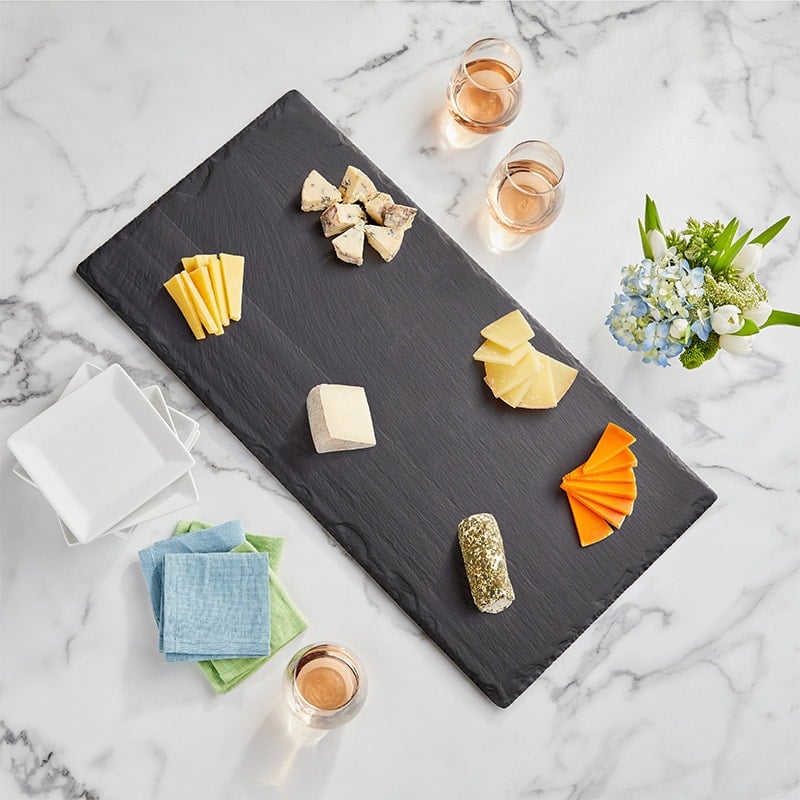
Shown here: Stilton, Manchego, Mimolette, herbed goat cheese, Saint-Andre cheese, Parmigiano Reggiano
For smaller boards, stick with two types of cheese you know your guests volition enjoy. If yous want to get larger, increase the number to 4 or 6 kinds of cheese. When adding a unique or offbeat cheese, utilize it sparingly considering it's probably more expensive and won't be as popular with all your guests. We recommend adding cheeses from these categories:
- Soft cheese - Start with 8 oz. of soft cheese, like brie, chevre, or camembert.
- Semi-firm cheese or hard cheese - Add viii oz. of medium-firm and/or aged cheese like cheddar, gouda, or manchego.
- Unique cheese - For your 3rd cheese, add four to vi oz. of something unexpected, like blue cheese or Mimolette (an aged moo-cow'southward milk cheese from France).
Please annotation: For ease of serving, pre-slice all the cheeses before putting them on the lath. If you are serving a very soft cheese, such every bit chevre, you lot can set it on a small dish or a slice of parchment with a cheese knife, which helps to maintain the appeal of your board.
Shop All Block Cheeses
2. Charcuterie Board Meats
The adjacent step is to add charcuterie meats to your board. You can commencement to fill in some of the space between the cheeses.
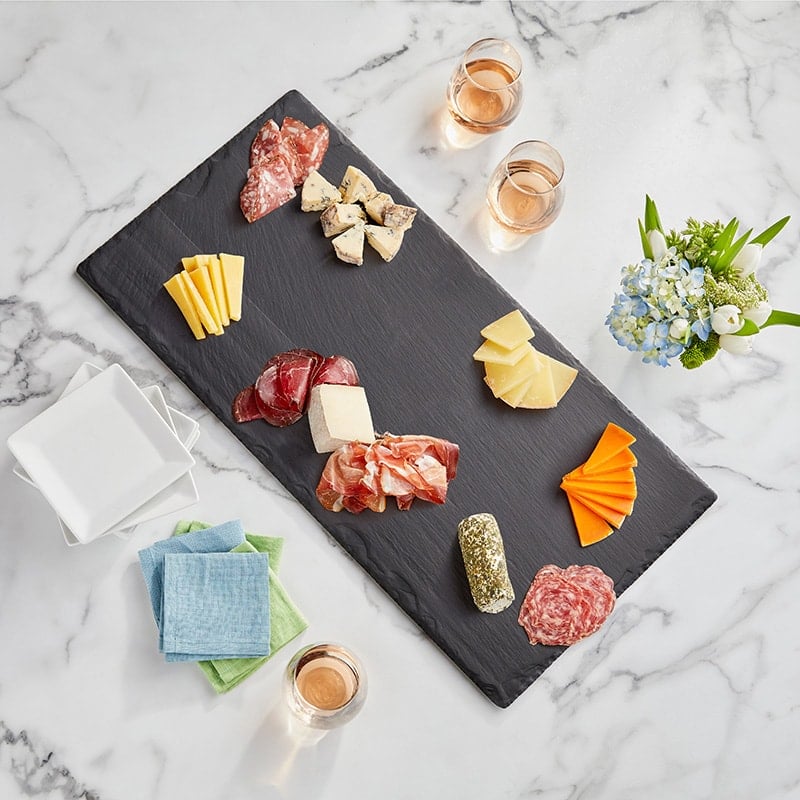
Shown hither: Soppressata, hard salami, speck, prosciutto
Think you'd like your board to be quick and classic? Become for popular meat options like salami and prosciutto. Expanding your horizons? Try some less typical selections like guanciale, coppa, or lardo. Endeavour using charcuterie meats from these categories:
- Dry-Cured Salami - Add 4 to 6 oz. of thinly sliced peppered salami, soppressata, or cinghiale.
- Cured Ham - Add 2 to iv oz. of thinly sliced cured ham like prosciutto or Italian speck. These meats normally come pre-sliced, but if you order from a charcuterie counter you can take it sliced to your desired thickness.
- Pate or Mousse - For a traditional charcuterie board, add together 6 to 8 oz. of land pate or mousse. Pate has a firm texture and tin be placed direct on the board. Mousse has a smoothen texture and should be served in a dish or ramekin to keep the board make clean.
Please annotation: If you choose a fatty meat, go along the board clean by placing a small piece of parchment beneath the slices.
Shop All Cured Meats
three. Charcuterie Fruits
Fruit adds color to your board and provides a flavour contrast to your meats and cheeses. Continue to fill up in the spaces of your lath with a diverseness of vibrant fruits.
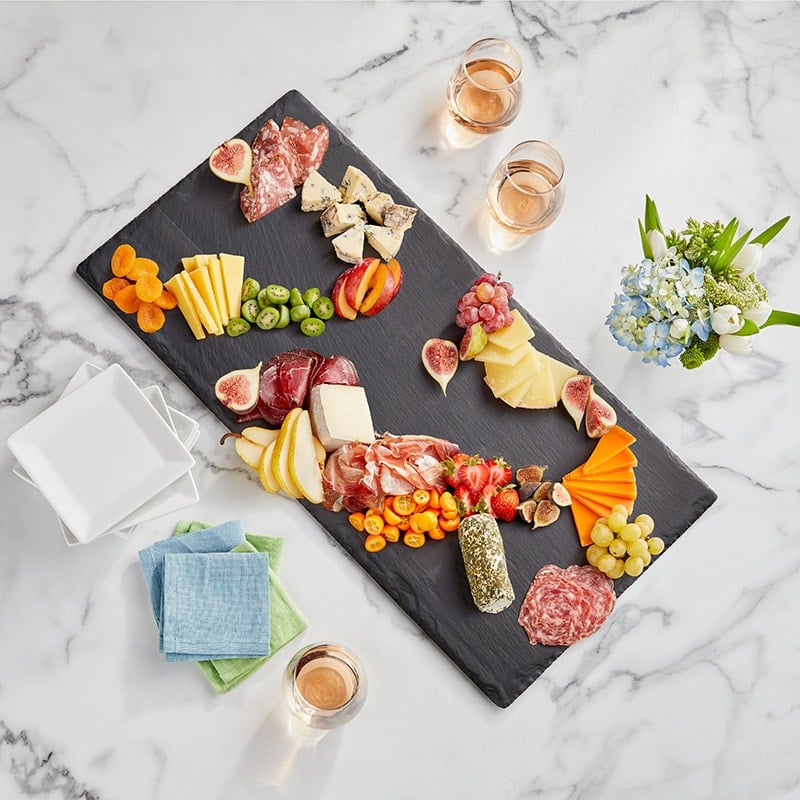
Shown hither: Figs, plum, green and ruddy grapes, strawberries, kumquats, pear, mini kiwis, dried apricots
For a pocket-sized board, a cluster of grapes and some sliced apple tree or pear should exist sufficient. If you want to build a large board like ours, cull a fruit from each category below:
- Grapes - Grapes are one of the best charcuterie fruits for piece of cake grazing. If they're in season, try Champagne grapes because they await especially elegant on a charcuterie lath. Cut the grape bunches into minor clusters and suit them on height of one another.
- Apples and Pears – You can't go incorrect with these cheeseboard-friendly fruits. Later slicing just earlier serving, soak the apples or pears in lemon juice. Gently pat them dry out earlier placing them on the board. The lemon juice prevents discoloration and adds a little actress citrus zing, which helps cut the richness of the cheese.
- Berries - Stick to halved strawberries, whole blackberries, or large blueberries. Raspberries tend to exist very soft and small blueberries tin gyre off the lath. If yous accept your centre attack raspberries or small blueberries, place them in a pocket-sized dish.
- Fresh Figs - If they're in flavour, halve or quarter a few fresh figs for your lath. They're not only beautiful, but they also pair well with cheese and charcuterie meats.
- Dried fruit - Dried apricots, cherries, and cranberries are pop choices if you choose to add dried fruit to your board. Yous can also try some of the more than unusual dried fruits like kiwis or mango.
Shop All Dried Fruits
4. Charcuterie Crackers
Crackers and bread options are an important part of your charcuterie board! Guests can layer their favorite foods on meridian of a cracker for a combination of delicious flavors and textures. Starting time filling in some of the remaining space with your cracker options.
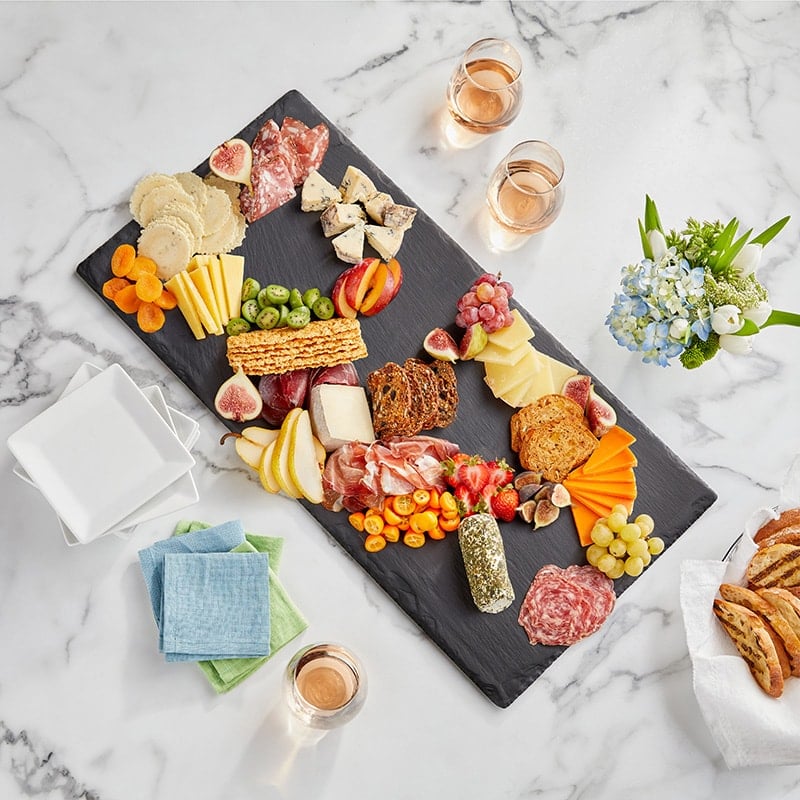
Shown hither: gluten-free crisps, jalapeno cheese crisps, raisin pecan crackers, pineapple basil crackers, grilled baguette (in basket)
For a small, basic board, choose sliced baguette and h2o crackers. If you're entertaining a larger oversupply, pick one or more options from each category below:
- Baguette - It's never a bad idea to take some thinly sliced baguette in a basket next to your lath. Some guests like to build a little crostino (Italian titbit) with the choices you've provided. Warm the baguette whole and piece information technology before serving. Or drizzle the slices with olive oil and rapidly grill them for a summertime crowd-pleaser.
- Crackers - Pick one balmy cracker that doesn't overpower the other flavors on the board, like a water cracker. And so choose one adventurous option, similar a rye or seeded cracker. If you opt for three types of crackers, choose a variety of flavors and textures.
- Grissini - Grissini are a type of thin breadstick with a well-baked texture. Their pencil-like shape adds more visual interest to your charcuterie board.
- Cookies - If you accept the room, add a crumbly shorbread cookie or chocolate dipped biscotti for a sweet option that pairs well with your other elements. Sweet and savory is a popular flavor combination!
Shop All Crackers
5. Charcuterie Lath Extras
Now information technology's time to complete your lath with extra elements that add together visual involvement and unique flavors. Fill in the final open spaces with your favorite finger foods, dips, and spreads.
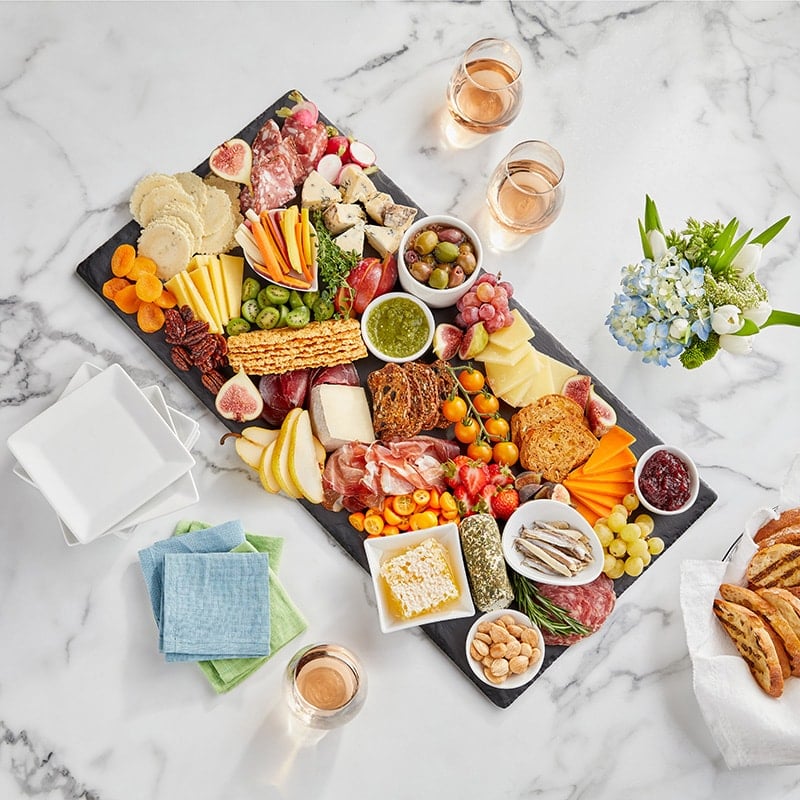
Shown here: radishes, rainbow carrot sticks, mixed olives, fresh thyme and rosemary, golden cherry tomatoes on the vine, raspberry preserves, white anchovies, honeycomb, Marcona almonds, candied pecans
There are many interesting and creative ways to round out your cheeseboard. Here are a few of our favorites:
- Jams or Preserves - Fruit preserves provide a sweet contrast to meats and cheeses.
- Fresh Herbs - Add sprigs of rosemary or thyme to your board.
- Edible Flowers - Endeavour placing blooms of edible flowers throughout your board.
- Basics and Seeds - Large nuts like whole pecans can be placed straight on the board. Effort adding a pocket-sized dish for basics similar peanuts.
- Olives - Olives are a popular choice for charcuterie boards thanks to their briny flavor. Serve pitted olives for convenience.
- Smoked Shellfish - For an adventurous option, add a small ramekin of smoked clams, oysters, or mussels.
- Anchovies - Try adding white anchovies, which are a balmy, slightly sweet version of the tiny fish.
- Tapenade - This spread, which is a savory combo of olives, capers, and anchovies, tin exist served right out of the jar or added to a ramekin.
4 Styles of Charcuterie Boards
At that place are a few different approaches yous tin accept while developing a concept for your charcuterie board. You lot can go with a regional arroyo and include items that all hail from the same country or town (i.eastward. y'all could make an unabridged lath based on the flavors of Alsace, France or Bologna, Italy). Or you can have a more freestyle approach and think near how your favorite flavors and textures would interpret onto i lath. Here are a few examples of the latter selection, to spark your creativity.
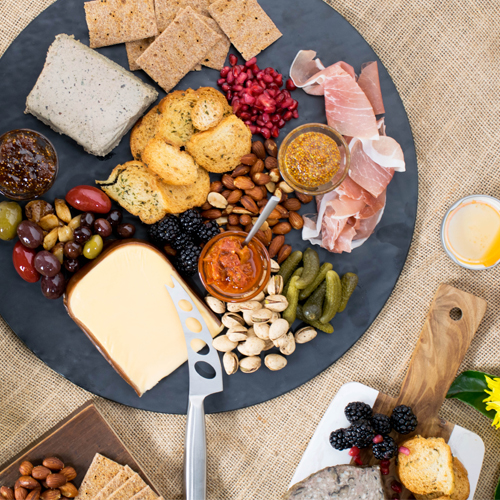
1. Pickles and Spreads
Pickled foods provide a tangy dissimilarity to sweetness, smokey meats and cheese. Choose a diverseness of pickled vegetables like pickled cauliflower, sugariness gherkins, or pickled red onion.
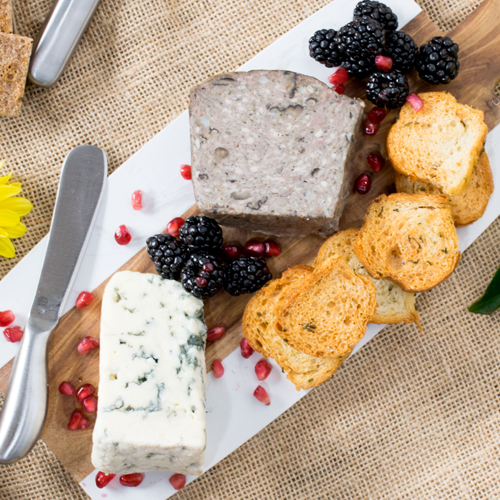
ii. Cheese and Fruit
Pairing the correct cheese and fruit provides a flavorful dissimilarity of taste and textures. Some classic fruit and cheese combinations are grapes with cheddar, pears with gouda, or cherries with brie.

3. Fresh Veggie and Citrus
Think crunchy fennel and blood orangish slices. The bright, fresh flavors of produce remainder out heavier, fattier meats like salami.
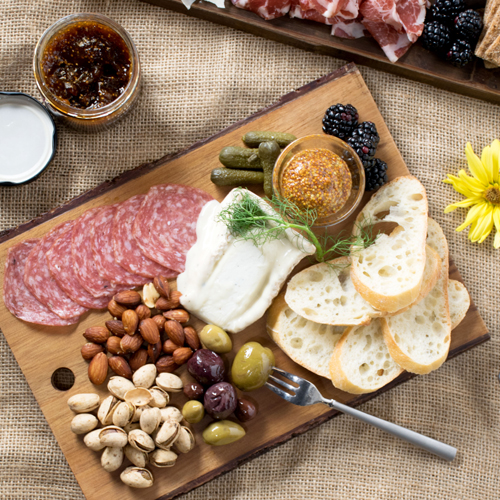
4. Toasted Bread and Meat
Slices of toasted bread provide a delicious vehicle for topping with meats, cheeses, and dips. Classic charcuterie items similar prosciutto and fig jam pair perfectly with toasted baguette.
Charcuterie FAQs
Can You lot Make a Vegan Charcuterie Board?
Aye, with a few slight adjustments, you can make a completely vegan charcuterie lath. In that location are many high-quality vegan cheeses on the market that can supercede the dairy cheese. Skip the meats and increase the number of fruits, crackers, and spreads. Try adding vegan meat alternatives like eggplant bacon, roasted chickpeas, and smokey mushroom hasty.
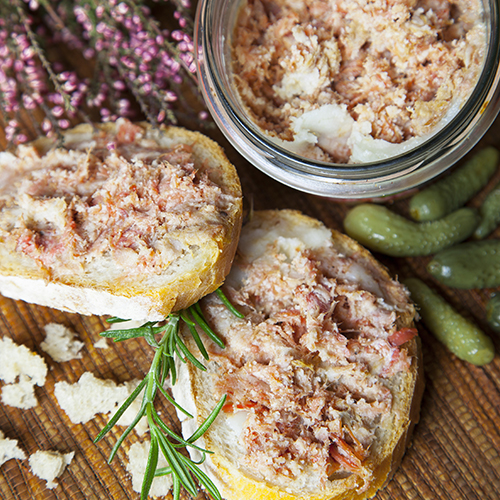
What Is Rillettes?
Rillettes is a French-style charcuterie meat product similar to pate but with a coarser texture. To brand rillettes, meat is tedious-cooked until it's soft enough to exist shredded. Rabbit, goose, and duck are common types of meat used for rillettes charcuterie.
How Do You Eat Rillettes?
Rillettes tin exist served cold or at room temperature, and then spread over sliced baguette or toast.
What Is Mousse?
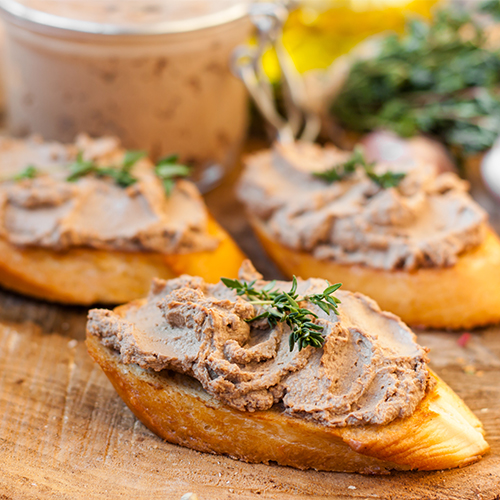
When talking near charcuterie, mousse refers to a mixture of meat and liver blended in a meat mixer and strained and so finely that information technology takes on a creamy texture. It's like to rillettes in that it's a spreadable meat dish, simply the master divergence is that information technology has a much smoother consistency that is similar to pate. One of the most popular kinds of mousse is chicken liver, which is frequently prepared with spices, foam, and even a bit of wine to achieve a rich flavor and silky texture.
How Practise You Consume Mousse?
Even though mousse must exist cooked earlier eaten, it's usually served cold and tastes great on sliced baguette or even pieces of fruit.
What Is Salami?
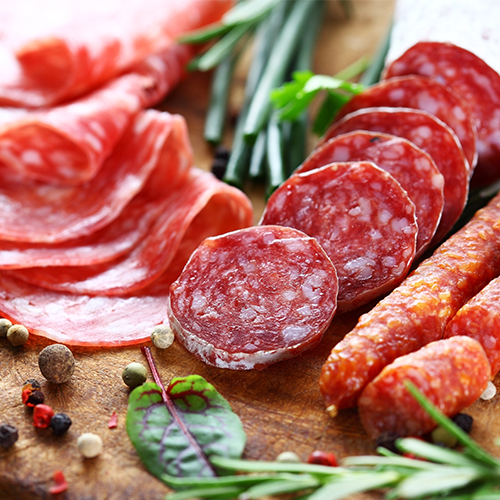
Salami is footing meat mixed with spices (and usually wine), encased in sausage casings, and and so dried. At that place are many styles of salami, some of the most common being Italy's soppressata, chorizo from Spain, and saucisson sec from France.
How Practise You Eat Salami?
The serving method largely depends on the type of salami. Genoa salami lends itself well to existence sliced sparse on a meat slicer and put on a sandwich. Chorizo is usually used as an ingredient that adds a robust flavor to cooked dishes and tin can exist found in anything from breakfast to fish entrees to sides of potatoes. Soppressata is commonly sliced a little thicker and served as an appetizer with cheese and fruit.
What Is Prosciutto?
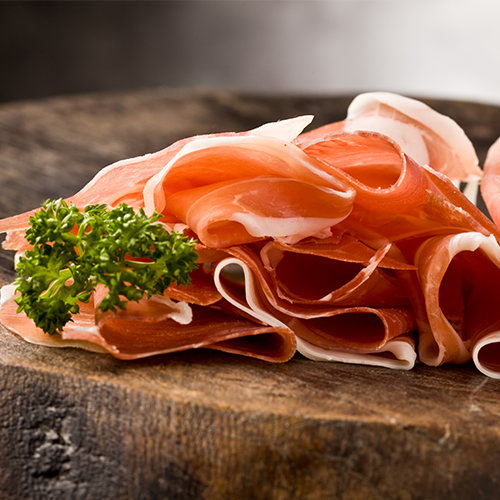
Prosciutto is a fatty cut of meat that's cured in salt and hung to dry out over several months. Prosciutto is normally fabricated from pork, but cured lamb, duck, or other meats that undergo the same process can also be considered a blazon of prosciutto.
How Do You Eat Prosciutto?
Because of its dense texture, prosciutto is typically sliced very thin on a specialty meat slicer and tin can exist served in a broad variety of means. You lot may run into it wrapped around fruit or covering other meats and cooked every bit a crispy outer vanquish. It'due south a delicious pizza topping: it can be diced and added to quiche or pasta dishes, and it can be eaten all on its ain!
When it comes to making a charcuterie lath, there's no right or incorrect style. Instead, focus on creating flavor combinations and providing your guests with a memorable dining experience. Knowledge of the types of ingredients used on a standard charcuterie lath tin help you lot break the rules finer. Soon you'll grow more comfortable with the craft of developing a delicious, cohesive board for your restaurant, bar, or cocktail party.
Source: https://www.webstaurantstore.com/blog/2318/what-is-charcuterie.html
0 Response to "What Is the Meaning of Again We Meet Around the Board"
Post a Comment